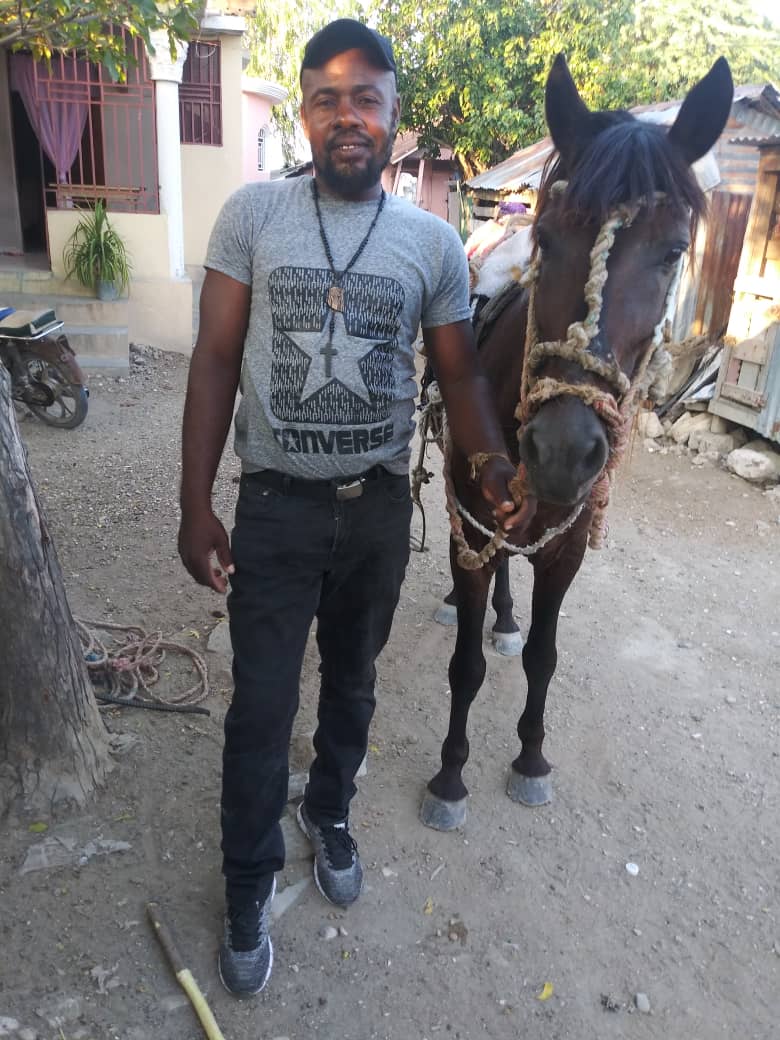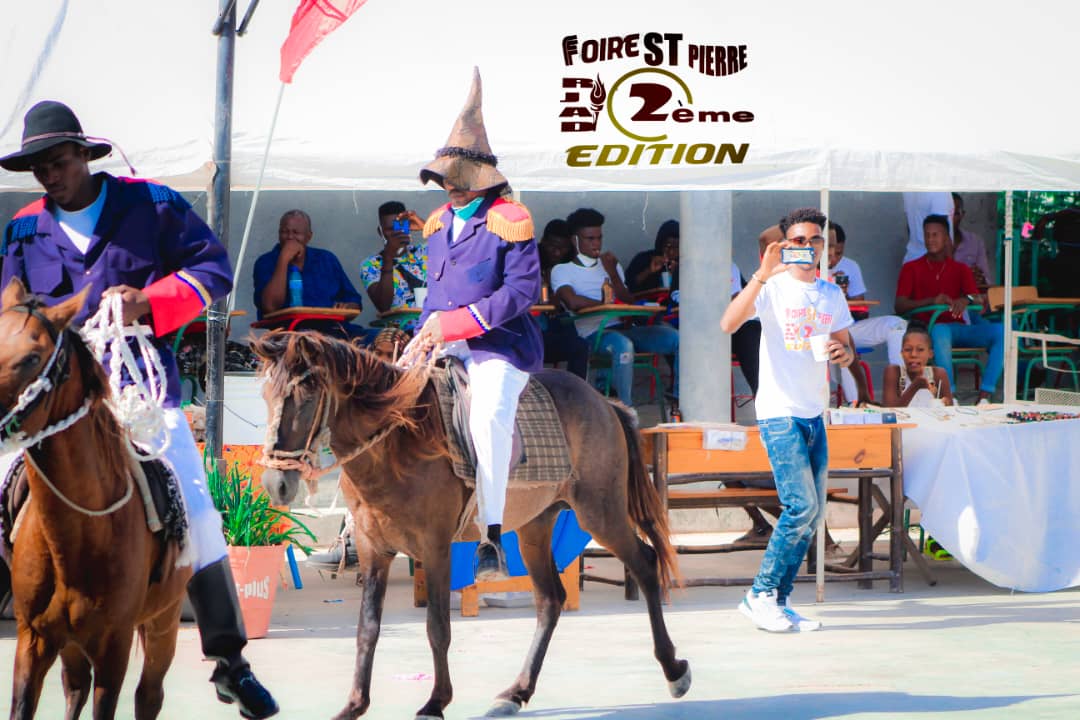“Alongside the contradance and the stick pull, it is a precious heritage that history has left us,” explains a trainer and rider from Desdunes
The knowing glances of the man and the horse meet one last time.
“Come on ! One-two, one-two,” resounds the voice of the trainer seated on the back of the muscular beast, whose coat shines in the rising sun.
A cloud of dust follows the rhythm of the sweating animal’s hooves as it runs.
This dressage sequence took place in May in Desdunes, in Artibonite, on land bordered by shrubs.
For Franck Zamor, houngan and horse trainer, this equestrian tradition dates back to the 19e century in Desdunes.
Maintaining it, for the Dunian trainers and riders contacted by AyiboPost, is a way of honoring the memory of their grandparents, but also of earning money and taking care of their families.
“Alongside the contradance and the stick pull, it is a precious heritage that history has bequeathed to us,” testifies Zamor, 56, also owner of the oldest equestrian club still active in the commune: “Kavalye Ansanm Ki Vle”.
Franck Zamor, president of “Kavalye Ansanm Ki Vle”, the oldest equestrian club in the town of Desdunes, gives directions to his riders during a funeral parade in the town.
Created in 1958 by his father, this club, with a dozen members, proudly carries the standard throughout the country.
“Not all Desdunians are interested in joining a club,” emphasizes Zamor.
“However,” he continues, “many consider it essential to have their horses trained, which they use for entertainment purposes or for the happiness of their guests.”
At the Kavalye Ansanm Ki Vle club, training a horse costs between 15,000 and 20,000 gourdes.
The carnival parade, the funeral ceremony, the parades during the days of historical celebration, as well as their participation in festivals such as Carifesta in 2015, are some of the activities where they have stood out.

Horse riders parade in Desdunes during a festive activity in the town. | © RJAD
“It was my grandfather who taught me dressage. I found it was important for him, so I continued,” explains Annys Marc, 60, rider and farmer.
“I enjoy riding a horse and the fact of having the impression that I can communicate with the animal makes it interesting,” Marc emphasizes to AyiboPost.
For this man, certain trained horses are inhabited by protective spirits.
It was my grandfather who taught me dressage. I found it was important to him, so I continued.
– Annys Marc, 60 years old
Berg-Henson, eighteen years old, carries out this activity because the passion was instilled in him by his older cousin.
For two years, the young man’s time has been divided between his studies and his great interest in horses.
An interest that politicians and other illustrious personalities seem to share with the Desdunians.
According to Franck Zamor, presidents Antoine Simon, Nord Alexis and René Préval got into the habit of summoning the skill of horses and the talent of Desdunian riders to make long journeys or to brighten up electoral campaigns.
Dressage requires the knowledge passed down from grandparents, but also an assortment of tools such as ropes, saddles, and packsaddles.
“A horse is suitable for dressage from its second year,” explains Zamor.

Rigaud Farot, a horse trainer in Desdunes, poses proudly with his horse.
Depending on the animal, the process can last three months or more.
Younger animals master movements faster than others.
To save time, the owner of “Kavalye Ansanm ki vle” relies on his long experience to anticipate the animal’s learning pace.
“I know how to read a horse’s footsteps,” he says.
According to Zamor’s categorization, there is the djong horse, the three cases and the natural.
They all have different training dispositions.
Bouyay, jumping and installation are the three stages of dressage.
The most important being the first, because it is the one during which the animal is tested and prepared for the rest of the process.
Bouyay, jumping and installation are the three stages of dressage.
The second being the phase of learning the movements, which can be dances or sequences of particular steps.
Finally, comes the final phase called installation.
After the latter, the horse executes the learned movements alone, once in situation.
Unlike ordinary horses, those who have followed this process have a special lifestyle.
The rest of their existence takes place between the stable and the shows.
Some, considered full members of their masters’ family, are buried with care at the end of their lives.
Desdunes is not the only place in Haiti with this equestrian practice.
Similar activities exist in other towns in the country such as Fonds-des-nègres and Petit-Goâve.
Read also: Pictures | Bullfights, a popular and lucrative tradition in Léogane
Alongside these equestrian traditions anchored in local culture, there is Olympic equestrianism in Haiti, managed by the Haitian Equestrian Federation since 1999.
In 2015, a development plan municipal had included dressage as an element to be valued in the local cultural heritage of Desdunes. According to this plan, Desdunes and its 2,000 horses could attract tourists.
The results did not live up to expectations, according to three horse trainers and riders who spoke to AyiboPost.
Mayor Fanord Pierre claims to be making certain efforts, but nevertheless admits that the municipal administration does not have sufficient resources to put in place infrastructure aimed at preserving and promoting this cultural heritage.

Horse riders parade in Desdunes during a festive activity in the town. | © RJAD
The security situation in the Artibonite, the disinterest of younger generations, livestock theft and the increasingly excessive consumption of horse meat scare Franck Zamor and his team regarding the preservation of this tradition.
Read also: The consumption of horse meat is becoming popular in Haiti
The man says he has already lost at least two of his animals, stolen from his stable.
The Saint-Pierre patronal festival remains the last great rampart for horse riding in the region for several years.
In June, it attracts visitors from all walks of life, who come to watch the parades where men in uniform perform breathtaking acts with their horses.
“I would like this to continue to exist over time, but I am very worried,” Zamor confides to AyiboPost.
Par Wethzer Piercin
Cover image: Horse dressage parade in Desdunes during a festive activity in the town. | © RJAD
Watch this AyiboPost report published December 2021 on the practice of “stick pulling” in Haiti which is a form of Haitian martial art:
Keep in touch with AyiboPost via:
► Our channel Telegram : Click here
► Our Channel WhatsApp : Click here
► Our Community WhatsApp : Click here


